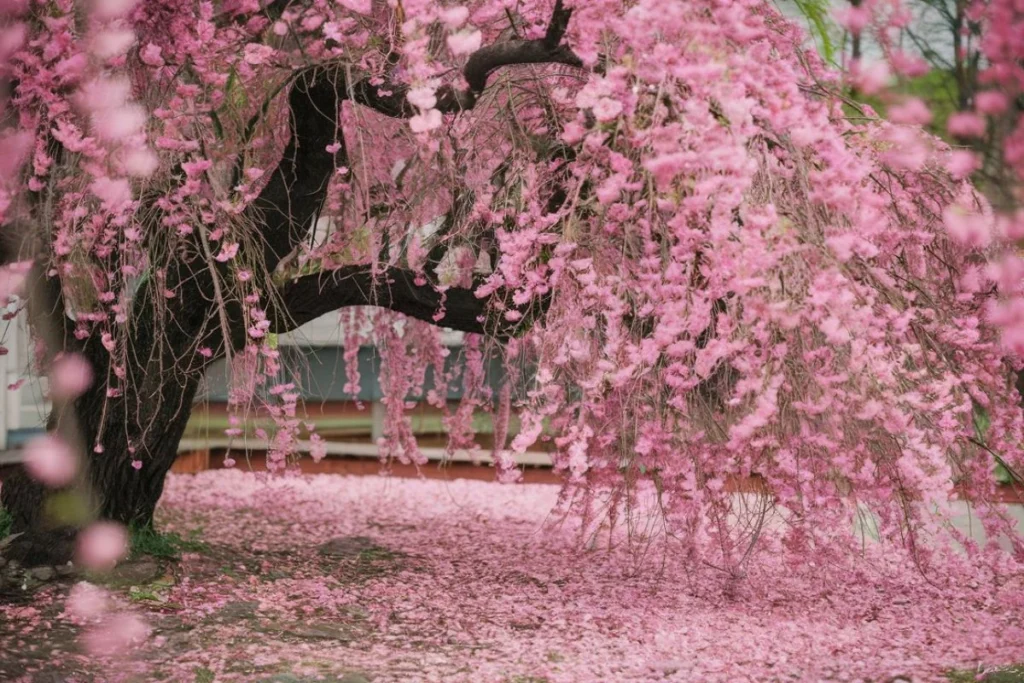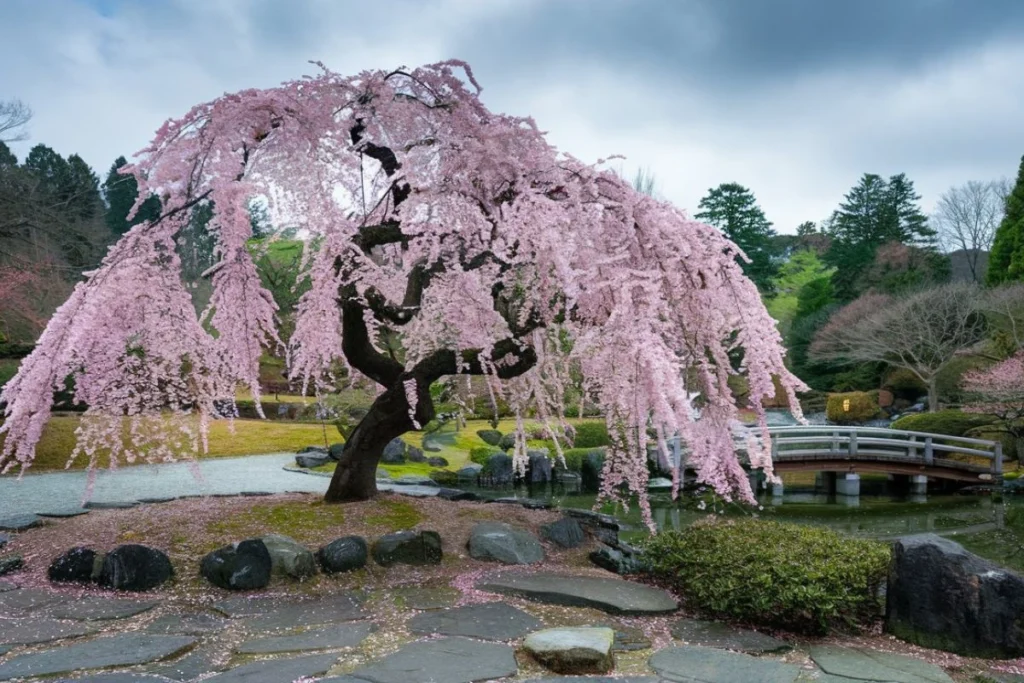The weeping cherry tree is a captivating ornamental tree that enchants with its cascading branches adorned with delicate blossoms. A true showstopper in gardens and parks, this tree symbolizes beauty, renewal, and the fleeting nature of life. Whether you’re a gardening enthusiast or someone who appreciates the beauty of nature, the weeping cherry tree is a timeless addition to any landscape.
This comprehensive guide explores the history, varieties, growing tips, care requirements, and cultural significance of the weeping cherry tree. By the end, you’ll have a deeper appreciation for this majestic tree and the tools to nurture its elegance in your own garden.
1. An Overview of the Weeping Cherry Tree
The weeping cherry tree (Prunus subhirtella or Prunus pendula) is a species of flowering cherry tree renowned for its distinctive arching branches that “weep” gracefully toward the ground. Native to Japan, it has become a popular ornamental tree worldwide due to its breathtaking blooms and year-round charm.
1.1. Key Characteristics
- Height: Weeping cherry trees usually reach heights to 30 feet.
- Blooming Season: The tree produces stunning blossoms in early to mid-spring.
- Flowers: The blooms range from pure white to soft pink, depending on the variety.
- Foliage: After flowering, the tree develops vibrant green leaves that transition to gold or orange in the fall.
1.2. Why It’s Popular
- Stunning seasonal display of blossoms.
- Unique, cascading growth habit.
- give it a sense of tranquility to any place.
2. The History of Weeping Cherry Trees
Weeping cherry have a rich cultural and historical background, particularly in Japan, where they are celebrated as symbols of renewal and ephemeral beauty.
2.1. Japanese Origins
In Japan, cherry trees, known as sakura, are deeply tied to cultural traditions. The practice of hanami (cherry blossom viewing) dates back over 1,000 years. During the spring, People enjoy the beauty of cherry blossom trees in a romantic scene.
2.2. Global Spread
In the early 20th century, Japan gifted cherry trees, including weeping varieties, to several countries as a gesture of goodwill. Today, these trees are cherished in the U.S., Europe, and beyond, often planted in parks and public spaces.
3. Varieties of Weeping Cherry Trees
There are several types of weeping cherry trees, each with its unique features. Some of the most popular varieties include:
3.1. Higan Weeping Cherry (Prunus subhirtella pendula)
- Flowers: Light pink blossoms.
- Growth Habit: Vigorous with a graceful weeping form.
- Hardiness: Tolerates a wide range of climates.
3.2. Snow Fountain Weeping Cherry (Prunus x ‘Snofozam’)
- Flowers: Pure white blooms.
- Size: Compact, reaching 8–15 feet tall.
- Ideal For: Small gardens or urban spaces.
3.3. Pink Weeping Cherry (Prunus pendula)
- Flowers: Bright pink flowers.
- Aesthetic: Dramatic and vibrant, perfect as a focal point.
3.4. Double Weeping Cherry (Prunus serrulata ‘Kiku-shidare-zakura’)
- Flowers: Double pink blossoms with a ruffled appearance.
- Appearance: Extravagant and full, resembling pom-poms.

4. Cultural Significance of Weeping Cherry Trees
4.1. In Japanese Culture
The cherry tree embodies the ephemeral nature of life. Its brief blooming period reminds people to appreciate the present moment and the fleeting beauty of existence.
4.2. A Symbol of Renewal
In numerous cultures, cherry blossoms signify the arrival of spring, representing renewal, hope, and new beginnings.
4.3. Worldwide Appeal
The aesthetic appeal of the weeping cherry tree has made it a favorite in public spaces, gardens, and cultural festivals around the world.
5. How to Plant a Weeping Cherry Tree
Proper planting is key to the success and longevity of your weeping cherry tree.
5.1. Choosing the Right Location
- Sunlight: Select a site with full sun exposure (6–8 hours daily).
- Soil: Properly draining soil is crucial to avoid root rot.
- Space: Ensure enough room for the tree’s mature size and cascading branches.
5.2. Planting Steps
- Prepare the Site: Dig a hole twice as wide as the root ball .
- Position the Tree: Set it in the hole, making sure the top of the root ball aligns with the ground level.
- Backfill and Water: Fill the hole with soil, gently tamping it down to eliminate air pockets, and water generously.
- Mulch: Add a layer of mulch around the base to retain moisture and regulate soil temperature.
6. Care and Maintenance
Weeping cherry trees require proper care to thrive and maintain their beauty.
6.1. Watering
- Young Trees: Water deeply once or twice a week during the first year.
- Established Trees: Water during dry spells, but avoid overwatering.
6.2. Fertilizing
- Apply a slow-release, balanced fertilizer in early spring prior to the start of new growth.
- Avoid excessive nitrogen, which can lead to more foliage and fewer blooms.
6.3. Pruning
- Cut away dead, diseased, or damaged branches in late winter or early spring.
- Trim crossing branches to maintain the tree’s elegant weeping shape.
6.4. Pest and Disease Control
Common issues include:
- Aphids: These sap-sucking insects can cause leaf curling and stunted growth.
- Powdery Mildew: A fungal disease identified by a white, powdery layer on the leaves.
- Preventative Measures: Regularly inspect your tree and apply organic pest treatments or fungicides as needed.
7. Landscaping Ideas with Weeping Cherry Trees
Weeping cherry trees are incredibly versatile and can enhance any landscape design.
7.1. Focal Point
Place a weeping cherry tree as the centerpiece of your garden for a dramatic visual effect.
7.2. Companion Planting
Pair it with complementary plants such as:
- Spring Bulbs: Daffodils or tulips for a layered blooming effect.
- Evergreens: To provide year-round structure.
7.3. Pathway Elegance
Plant weeping cherry trees along a garden path or driveway to create a welcoming, picturesque entrance.
8. Seasonal Appeal of Weeping Cherry Trees
Weeping cherry trees offer year-round interest:
- Spring: Blossoms steal the show with their delicate beauty.
- Summer: Lush green foliage provides shade and vibrancy.
- Fall: Leaves turn warm hues of gold or orange.
- Winter: The tree’s graceful branches stand out against snowy backdrops.
9. The Weeping Cherry Tree in Public Spaces
9.1. Parks and Botanical Gardens
Weeping cherry trees are often featured in public spaces due to their ornamental value and ability to attract visitors during spring.
9.2. Festivals
Cherry blossom festivals, such as the National Cherry Blossom Festival in Washington, D.C., celebrate the beauty of these trees and their cultural significance.
10. Frequently Asked Questions (FAQs)
10.1. How long do weeping cherry trees live?
Weeping cherry trees usually have a lifespan more than 35 years, but with proper care, they can live longer.
10.2. When do weeping cherry trees bloom?
Most varieties bloom in early to mid-spring, depending on the climate and species.
10.3. Is it possible to grow a weeping cherry tree in a container?
Yes, smaller varieties like the Snow Fountain Weeping Cherry can thrive in large containers with proper care.
10.4. Do weeping cherry trees produce fruit?
Some varieties produce small, inedible cherries that attract birds, while others are strictly ornamental.
10.5. Are weeping cherry trees deer-resistant?
While not completely deer-proof, their branches and blossoms are less attractive to deer compared to other plants.
10.6. Can weeping cherry trees survive in colder climates?
Many varieties are cold-hardy and can tolerate temperatures down to USDA Zone 5. However, they require protection from harsh winds and extreme cold.

11. Conclusion
The weeping cherry tree is a masterpiece of nature, combining elegance, cultural significance, and seasonal charm. From its delicate springtime blossoms to its cascading branches, this tree adds a touch of grace to any setting. Whether you’re planting one in your backyard or admiring them in a park, the weeping cherry tree offers a timeless reminder of life’s fleeting beauty and the importance of cherishing each moment.
By understanding its care needs and unique qualities, you can enjoy the splendor of a weeping cherry for decades. Bring a piece of tranquility and artistry to your landscape with this iconic tree, and let it inspire you throughout the seasons.

